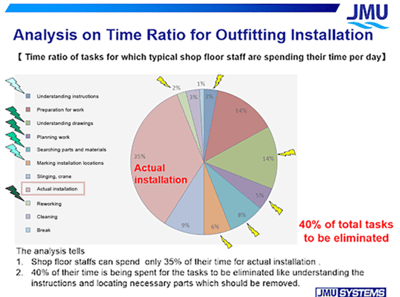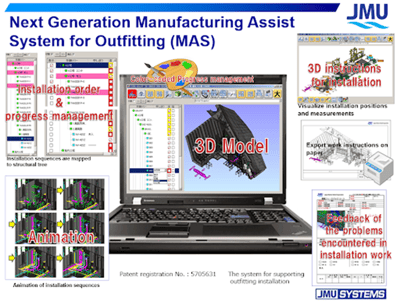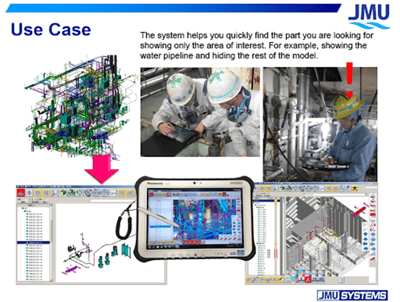Corporate Profile
Japan Marine United (JMU), was created in January 2013 by the merger of IHI Marine United and Universal Shipbuilding and is the 2nd largest shipbuilding company in the world. JMU manufactures a wide variety of vessels including supertankers, container ships, car ferries and military ships.
Business Challenges
Faced with increasing global competition and experienced workers retiring, JMU launched a Digital Manufacturing (DM) initiative to improve their manufacturing processes. The centerpiece of their DM effort was the development of a “Next Generation Manufacturing Assist System for Outfitting (MAS)” based Lattice Technology’s XVL products.
“Outfitting” means to install equipment to the hull. According to JMU’s Mr. Nakamoto, there was concern about outfitting inefficiency as far back as 2007. “Many skilled workers were retiring and were being replaced by new workers who didn’t have the same level of experience and knowledge. This generated concern about causing inefficiency in the installation work. This was the trigger for JMU to undertake the development of MAS to address these problems and to seek further reductions in manufacturing time.”
Mr. Nakamoto’s vision was inspired by the assembly instructions for hobby models which are easily understood. Traditional manufacturing assembly instructions require high skill levels and a lot of time for workers to understand the complex drawings. Mr. Nakamoto aimed to develop a system that allows workers to visualize the parts and the installation order intuitively, and to easily recognize the before and after configurations like hobby model assembly instructions.

Business Strategy and Objectives
JMU chose XVL for their new MAS. First, they converted the 3D CAD design data to XVL, then used XVL Studio to create a process tree and author work instructions. They also started making their own enhancements, which include automatically generating the installation process from the 3D data, automatically adding the mounting dimensions for parts and equipment, and validating the installation process using animations.

XVL 3D Visualizations of Process Order Produce Significant Time Reductions
MAS provides XVL 3D visual work instructions to multiple JMU shipyards, which can be viewed on PCs and tablets. Having a choice, outfitters now prefer to perform the installations by referencing 3D XVL Work Instructions on tablets.

The JMU Manufacturing Assist System (MAS) is specifically designed to help new technicians learn the installation process. It includes features like easy-to-understand graphics, 3D animations, and easy-to-use feedback forms that shorten the learning curve.
Results
According to Mr. Nakamoto, JMU is achieving significant ROI – especially when handling complex blocks and installing large components. “XVL leverages its strength in handling large models. Accordingly, we enjoyed great benefits when calculating extraction paths in complex piping models and simulating the installation of large equipment. In such situations, 30% time reduction was achieved compared to the traditional method.”
When building a new ship, the 1st ship takes the most time, but the time decreases substantially for each subsequent ship. The introduction of MAS enabled JMU to manufacture the 1st ship in the time equivalent to that of the 3rd ship in the past.
Based on these successful results, JMU developed a “Manufacturing Assist System for the Hull” based on MAS to manufacture hulls.
“In the hull manufacturing process, there is a critical procedure called ‘Define Welding Line’. In the past, we tried to automate this procedure with 3D CAD, however, the 3D CAD data was too heavy, and the project failed. However, the XVL-based system is very agile and has no performance problems. With MAS and MAS for Hull, XVL has become essential for our DM initiative.” - JMU

Summary
JMU gained a large amount of ROI through applying XVL to improve their Work Instruction process. This was done through creating 3D Work Instructions that can be viewed on PCs and Tablets. Having these interactive Work Instructions reduced the expertise required of workers, along with being able to publish from large scale models.

